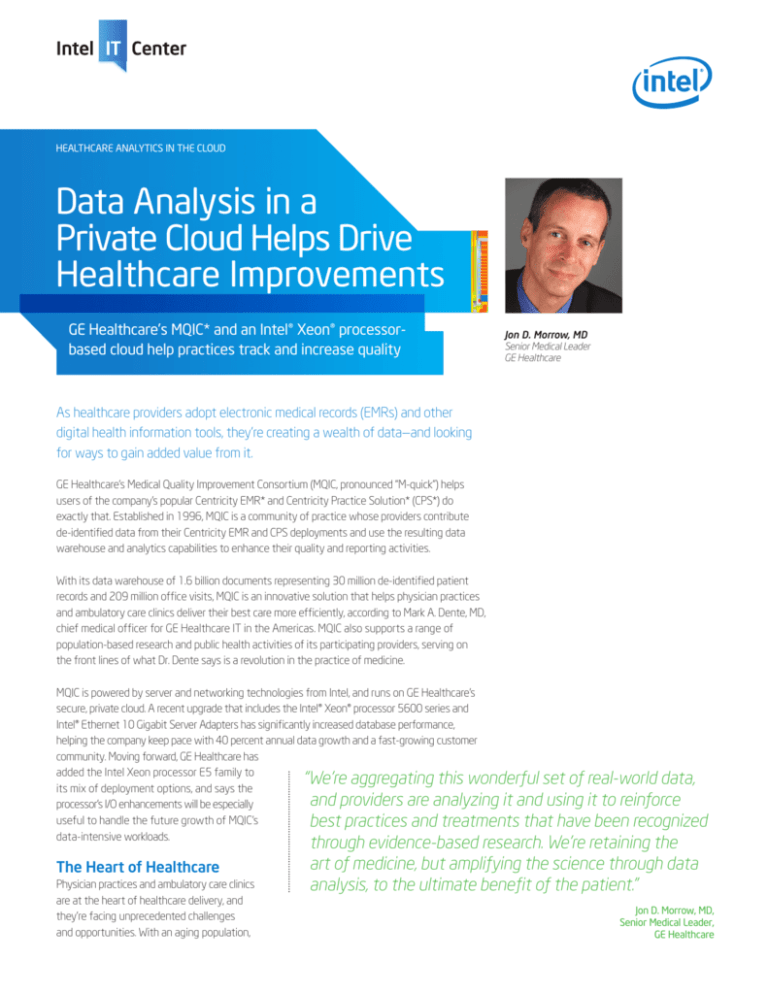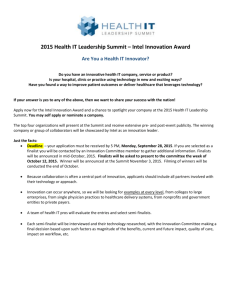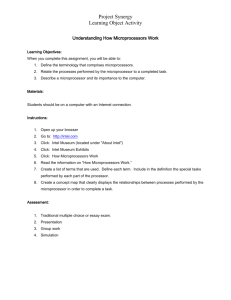
HEALTHCARE ANALYTICS IN THE CLOUD
Data Analysis in a
Private Cloud Helps Drive
Healthcare Improvements
GE Healthcare’s MQIC* and an Intel® Xeon® processorbased cloud help practices track and increase quality
Jon D. Morrow, MD
Senior Medical Leader
GE Healthcare
As healthcare providers adopt electronic medical records (EMRs) and other
digital health information tools, they’re creating a wealth of data—and looking
for ways to gain added value from it.
GE Healthcare’s Medical Quality Improvement Consortium (MQIC, pronounced “M-quick”) helps
users of the company’s popular Centricity EMR* and Centricity Practice Solution* (CPS*) do
exactly that. Established in 1996, MQIC is a community of practice whose providers contribute
de-identified data from their Centricity EMR and CPS deployments and use the resulting data
warehouse and analytics capabilities to enhance their quality and reporting activities.
With its data warehouse of 1.6 billion documents representing 30 million de-identified patient
records and 209 million office visits, MQIC is an innovative solution that helps physician practices
and ambulatory care clinics deliver their best care more efficiently, according to Mark A. Dente, MD,
chief medical officer for GE Healthcare IT in the Americas. MQIC also supports a range of
population-based research and public health activities of its participating providers, serving on
the front lines of what Dr. Dente says is a revolution in the practice of medicine.
MQIC is powered by server and networking technologies from Intel, and runs on GE Healthcare’s
secure, private cloud. A recent upgrade that includes the Intel® Xeon® processor 5600 series and
Intel® Ethernet 10 Gigabit Server Adapters has significantly increased database performance,
helping the company keep pace with 40 percent annual data growth and a fast-growing customer
community. Moving forward, GE Healthcare has
added the Intel Xeon processor E5 family to
“We’re aggregating this wonderful set of real-world data,
its mix of deployment options, and says the
and providers are analyzing it and using it to reinforce
processor’s I/O enhancements will be especially
useful to handle the future growth of MQIC’s
best practices and treatments that have been recognized
data-intensive workloads.
The Heart of Healthcare
Physician practices and ambulatory care clinics
are at the heart of healthcare delivery, and
they’re facing unprecedented challenges
and opportunities. With an aging population,
through evidence-based research. We’re retaining the
art of medicine, but amplifying the science through data
analysis, to the ultimate benefit of the patient.”
Jon D. Morrow, MD,
Senior Medical Leader,
GE Healthcare
HEALTHCARE ANALYTICS IN THE CLOUD
At a Glance
Project
• Securely analyze de-identified data in
more than 30 million health records to help
healthcare organizations improve quality,
benchmarking, and population-based
medical research
Accomplishments • Implemented a robust, secure, and highperformance cloud that supports MQIC’s rapid
growth in users, data volumes, and analytics
requirements
• Solution meets MQIC members’ needs for
resource-intensive analytics of massive data
volumes without a performance drain on
their own systems
• Solution supports peak demands during
month-end reporting periods without
costly overbuilding
Lessons Learned • Look for new ways to capture value
from your existing data. Cloud computing
provides opportunities to aggregate and
analyze data from multiple sources
• Standardize the data center on server and
network technologies from Intel to gain the
processing performance and throughput
for deep analysis of massive data stores
• Plan ahead for data growth. With GE
Healthcare’s new data center, rearchitected
data platform, and choice of Intel®
technologies, the MQIC team is ready to
handle further growth in members and
data volumes
practices see more patients suffering from
multiple complex chronic conditions. To care
for these patients, providers are adopting
innovative approaches that promote
coordinated and integrated care, but bring a
range of new information, care coordination,
and workflow requirements.
Payment models are changing as well, with an
increased focus on accountability for the value
of care provided and an emphasis on managing
specific patient populations (such as patients
with diabetes) as well as individual patients.
Practices can earn value-based payment
incentives (and avoid penalties) by applying
evidence-based best practices and making
meaningful use of healthcare information
systems. To qualify for these incentives,
however, they must generate detailed quality
and performance measures, often housed in
EMRs and other electronic data sources, to help
manage care within the practice as well as to
report to payers and government agencies.
All these trends point to EMRs and tools such
as MQIC as key elements of the solution. Using
MQIC’s data warehouse, analytics, and reporting
capabilities, the community of healthcare
providers at more than 550 practices across the
U.S. are enabled to better manage their complex
patient loads, implement new care models,
adhere to best practices, demonstrate
meaningful use, and save time and effort while
participating in value-based-payment and
accountable-care programs.
MQIC enables healthcare providers to analyze
data and demonstrate their success in applying
clinical best practices. “The information in MQIC
can help practitioners go deep on the data
about a particular patient and go long across a
patient population,” says Jon D. Morrow, MD,
senior medical leader at GE Healthcare and
director of MQIC. “If practices or providers want
to know what percentage of their younger
asthma patients received a corticosteroid or
how many of their diabetic patients had the
recommended foot or eye exams, the provider’s
data view can tell them that very quickly.
With the patient-level views, MQIC can then
allow the practice to hone in on which patients
are outside of the guidelines, reminding their
providers to offer the recommended care and
allowing the practice administrators to drive
the necessary quality-improvement efforts.”
The Third Revolution: Bringing
Data to the Bedside
MQIC is part of what Dr. Dente calls the third
revolution in healthcare. “The first revolution
was the germ theory of disease of the late
19th century, when physicians were
encouraged to wash their hands prior to
surgery,” Dr. Dente says. “Then came the use
of antibiotics in the 1940s and ‘50s. Now
we’re entering an era of understanding the
importance of data analytics and translational
medicine, bringing discoveries from informatics,
genomics, and proteomics to the bedside, and
bringing them much faster than has been
possible in the past. It is revolutionary.”
That blend of analytical breadth and depth
helps providers improve patient care. “We’re
aggregating this wonderful set of real-world
data, and providers are analyzing it and using it
to reinforce best practices and treatments that
have been recognized through evidence-based
research,” says Dr. Morrow. “We’re retaining the
art of medicine, but amplifying the science
through data analysis, to the ultimate benefit
of the patient.”
MQIC data come from more than 30 million
longitudinal EMR records that geographically
and demographically reflect the overall United
States population. Information is stripped of
HEALTHCARE ANALYTICS IN THE CLOUD
“We’re entering an era of understanding the importance of data
analytics and translational medicine, bringing discoveries from
informatics, genomics, and proteomics to the bedside, and
bringing them much faster than has been possible in the past.
It is revolutionary.”
Mark A. Dente, MD,
Chief Medical Officer, Americas,
GE Healthcare
patient identifiers and handled in strict
accordance with governmental and industry
regulations, to protect patient confidentiality.
In addition to the direct clinical application
supporting provider quality-improvement
initiatives and pay-for-performance incentive
programs, the de-identified MQIC data are also
used to drive customers’ population-based
research ranging from disease surveillance to
treatment comparisons. “Research allows the
power of MQIC to benefit patients well beyond
the office setting,” says Dr. Morrow.
Data Analytics in the Cloud
MQIC members access its quality reporting
and submission services through a Webbased portal or through their Centricity
Practice Solution interface. Submission
reports are aligned with leading value-based
payment and quality programs, making them
easy for providers to use in selecting their
reporting measures. In some cases MQIC
can submit reports electronically on behalf
of members, streamlining the submission
work that practices must do to qualify for
incentive payments.
Since MQIC runs in GE Healthcare’s private
cloud, members get the analytics capabilities
they need without having to build and
maintain additional local infrastructure.
“When you’ve got billions of rows of data, the
reports are very resource-intensive, and the
performance and storage requirements are
significant,” explains Andre Sublett, chief
architect of the GE Healthcare Analytics
Center of Excellence. “Because we do the
storage and infrastructure maintenance in our
cloud infrastructure, our customers can focus
on providing great care and meeting the
criteria to qualify for the incentive payments.”
With its foundation of Intel technologies, this
private cloud also meets GE Healthcare’s own
requirements. “The cloud is a great opportunity
to manage total cost of ownership, manage
our data growth, and get the performance we
need to deliver the analytic insights from a
multi-terabyte database,” Sublett adds.
“Cloud computing is also well suited to
aggregating data across multiple healthcare
providers and organizations, which is important
for customers’ research insights.”
Standardizing on Intel Xeon
Processors
To stay ahead of the dramatic growth in
healthcare IT, GE Healthcare recently opened
a 40,000 square foot Tower Annex Data
Center and re-architected its MQIC
infrastructure. The MQIC technology team
moved its Oracle 10g database, which
previously ran on HP Integrity* servers with
Intel® Itanium® processors and HP-UX*, to an
Oracle Exadata* data machine. The Exadata
system uses the Intel Xeon processor 5600
series for both servers and storage controllers,
with an InfiniBand* interconnect to increase
data throughput. MQIC’s web tier and SAS*
statistical software engine run on HP
ProLiant* DL380 G7 servers, also powered by
the Intel Xeon processor 5600 series.
“Intel Xeon processors are a standard in our
data center,” says Ron Brahm, program
manager of technology services for GE
Healthcare. “They give us the performance
we need, and we like the versatility, since we
can support a wide variety of program loads
while maintaining consistency in our
infrastructure. They’re extensible, supportable,
and upgradeable, and the Intel road map
means we’re always looking to the innovations
in the next generation.”
Key Technologies
• GE Centricity* EMR, Centricity Practice
Solution, and MQIC*
• SAS Analytics*
• HP ProLiant* DL380 servers based on the
Intel® Xeon® processor 5600 series
• Oracle Exadata* data machine with Intel
Xeon processor 5600 series-based servers
and storage controllers
• Intel® Ethernet 10 Gb Converged
Network Adapters
• VMware vSphere* ESXi* for virtualization
and cloud management
Intel Xeon processors also contribute to
an energy-efficient data center—a plus
for a company with GE’s strong record on
energy-saving innovations. The Intel Xeon
processor E5 family and 5600 series provide
capabilities that automatically regulate
power consumption and intelligently adjust
server performance to application demand,
maximizing both energy cost-savings and
system performance.
Performance and Scale to
Handle Data Growth
With its choice of Intel Xeon processors, the
MQIC technology team met the critical
requirements it established for its cloud
infrastructure. “We need affordable horizontal
scaling so we can maintain the same high level
of services against an exponentially expanding
set of data and increasing analytics demands,”
Sublett says. “We need to support multiple
operating systems, since we’re aggregating
information from multiple sources, including
many on older systems. We also need the
processing power for complex statistical data
compilation over billions of records. We have
a big requirement to pull data into memory,
so we need the ability to scale up on the
back end and scale out at the front end and
application tier.”
The new environment has improved
performance and processing capability,
delivering a consistent experience for
customers despite rising data volumes and
increasingly sophisticated analytics. “We
have seen performance gains of 20 percent,
HEALTHCARE ANALYTICS IN THE CLOUD
30 percent, even up to 40 percent in certain
areas,” says Sunil Luhadia, senior database
administrator at GE Healthcare. “We are also
able to process the increased workloads of our
membership, which is growing by 40 percent
per year. It would have been unthinkable to
support this growth without our recent upgrade.”
GE Healthcare is looking toward Intel’s nextgeneration processors to handle future growth.
“The Intel Xeon processor E5-2600 product
family provides excellent energy efficiency and
a significant increase in performance,” Brahm
says. “The new integrated I/O capabilities will be
very significant for data-intensive workloads
like MQIC.” Intel’s security features are also of
interest, including Intel® Advanced Encryption
Standard New Instructions (Intel® AES-NI)
for hardware-accelerated encryption,
and Intel® Trusted Execution Technology
(Intel® TXT) to help protect against malware
in a cloud environment.
Putting Analytics into Practice
All that high-powered technology is happily
transparent to Diane Hollingsworth, RNC,
MAOM, CPHQ. Hollingsworth is director of
quality and education at MedStar Physician
Partners, a member of MedStar Health. As a
veteran of paper-chart auditing, she says MQIC
not only makes her job easier, but is enabling
MedStar Health to utilize reporting tools to
help deliver higher-quality care in a more
efficient, sustainable fashion.
MedStar Physician Partners is an ambulatory
care leader with nearly 35 offices and more
than 129 healthcare providers in Washington,
D.C. and Maryland. Many of the group’s practices
are Level 3 Patient-Centered Medical Homes
(PCMHs), and the remaining practices are in the
process of certification. MedStar Health
provides care to 1.5 million patients each year,
and has been an MQIC member since 2003.
Hollingsworth uses MQIC analytics to
assess the quality of care delivered and
documented by MedStar providers and offices.
She also benchmarks MedStar against others
in the region or across the nation. “MQIC
is a phenomenal help in showing us the
opportunities to improve care, and we can drill
down on the data so that providers can trust
the data and are really willing to make changes
based on it,” she says.
When the data shows room for improvement,
Hollingsworth collaborates with the affected
individuals and groups to identify root causes
and develop new approaches. “Sometimes
providers are delivering the recommended
care but not documenting it, so they need
education on the use of the EMR,” she says.
“Sometimes the vocabulary isn’t aligned, so
we’ll work to clarify that. Sometimes we
modify office procedures and workflows.”
MQIC also helps MedStar save time and money in
demonstrating meaningful use and qualifying for
this and other key incentive programs available
through the U.S. Centers for Medicare and
Medicaid Services (CMS) and other organizations.
“MQIC has taken the time to validate and ensure
that the filters they have created are appropriate
for CMS standards, so we don’t have to have
someone in the back office trying to do that,”
Hollingsworth says. “With many of these
programs, it’s not just one report. It would take a
tremendous amount of time to run these reports
individually and make sure that all the filters are
correct. MQIC lets us maximize our efficiency,
supporting us in pursuing incentive opportunities
and making it much, much easier.”
Ultimately, says Hollingsworth, MQIC elevates
the whole conversation around practice
management and clinical quality. She shares
the de-identified data by office and provider,
so everyone can see their performance on key
metrics and track how it compares to others
within MedStar and externally—and members
of the practice are paying close attention.
“MQIC raises awareness of clinical guidelines
and best practices, and supports providers to
improve their practice overall,” Hollingsworth
says. “We have common-knowledge-based
discussions much more than we did when we
were on paper charts. When the medical
director does his road show and meets with
each practice, they talk about the MQIC
reports. Everyone knows where we are with
the metrics, and we talk about what the data
is telling us. We have a level of conversation
regarding performance metrics across a large
medical group that you wouldn’t have had
without the common base platform.”
Software and workloads used in performance tests may have been optimized for performance only on Intel microprocessors. Performance tests, such as SYSmark and MobileMark, are measured using specific computer
systems, components, software, operations and functions. Any change to any of those factors may cause the results to vary. You should consult other information and performance tests to assist you in fully evaluating your
contemplated purchases, including the performance of that product when combined with other products. For more information go to http://www.intel.com/performance.
Intel does not control or audit the design or implementation of third party benchmark data or Web sites referenced in this document. Intel encourages all of its customers to visit the referenced Web sites or others where
similar performance benchmark data are reported and confirm whether the referenced benchmark data are accurate and reflect performance of systems available for purchase.
Intel® AES-NI requires a computer system with an AES-NI enabled processor, as well as non-Intel software to execute the instructions in the correct sequence. AES-NI is available on select Intel® processors. For availability,
consult your reseller or system manufacturer. For more information, see http://software.intel.com/en-us/articles/intel-advanced-encryption-standard-instructions-aes-ni/
No computer system can provide absolute security under all conditions. Intel® Trusted Execution Technology (Intel® TXT) requires a computer with Intel® Virtualization Technology, an Intel TXT-enabled processor, chipset, BIOS,
Authenticated Code Modules and an Intel TXT-compatible measured launched environment (MLE). Intel TXT also requires the system to contain a TPM v1.s. For more information, visit http://www.intel.com/technology/security.
This document and the information given are for the convenience of Intel’s customer base and are provided “AS IS” WITH NO WARRANTIES WHATSOEVER, EXPRESS OR IMPLIED, INCLUDING ANY IMPLIED WARRANTY OF
MERCHANTABILITY, FITNESS FOR A PARTICULAR PURPOSE, AND NONINFRINGEMENT OF INTELLECTUAL PROPERTY RIGHTS. Receipt or possession of this document does not grant any license to any of the intellectual
property described, displayed, or contained herein. Intel® products are not intended for use in medical, lifesaving, life-sustaining, critical control, or safety systems, or in nuclear facility applications.
© 2012, Intel Corporation. All rights reserved. Intel, the Intel logo, and Intel Xeon are trademarks of Intel Corporation in the U.S. and other countries.
1012/LJ/TDA/XX/PDF
Please Recycle
327641-003US








